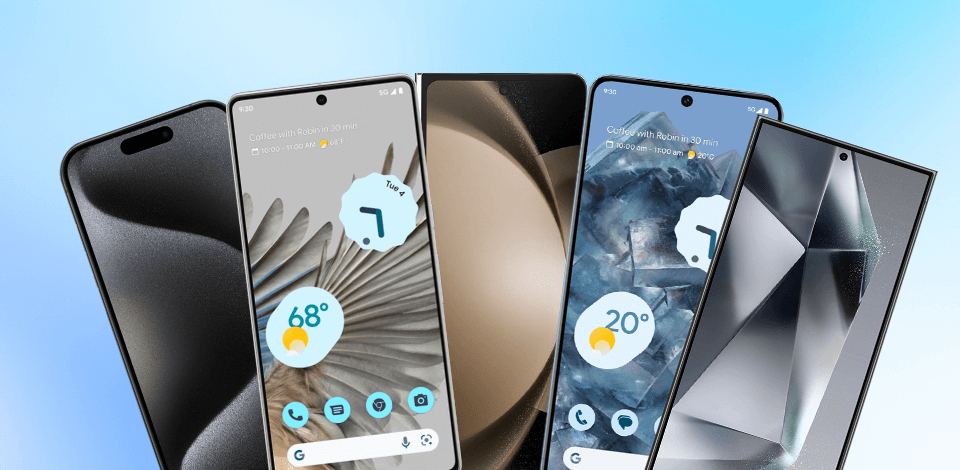
Discover which company offers the best camera phone – Samsung, iPhone, or Google?
Getting a smartphone with a high-quality camera is crucial if you’d like to take beautiful pictures wherever you are. It’s not particularly practical to pack a massive DSLR every time you leave your house, even if you’re a professional photographer.
An excellent phone camera can offer a pro-quality image sensor and, an expansive feature set, and allow you to enhance your photos in just a few taps.
If you’re interested in getting the highest camera resolution the market has to offer, I suggest you go with the Samsung Galaxy S24 Ultra. If you want to not only take pictures, but record videos as well, Apple iPhone 15 Pro Max should be right up to you. Alternatively, if you prefer to stay within the Android ecosystem, you can get the more budget-friendly Google Pixel 8 Pro, while leveraging its AI-best tools and smart editing functionality.
Highest resolution
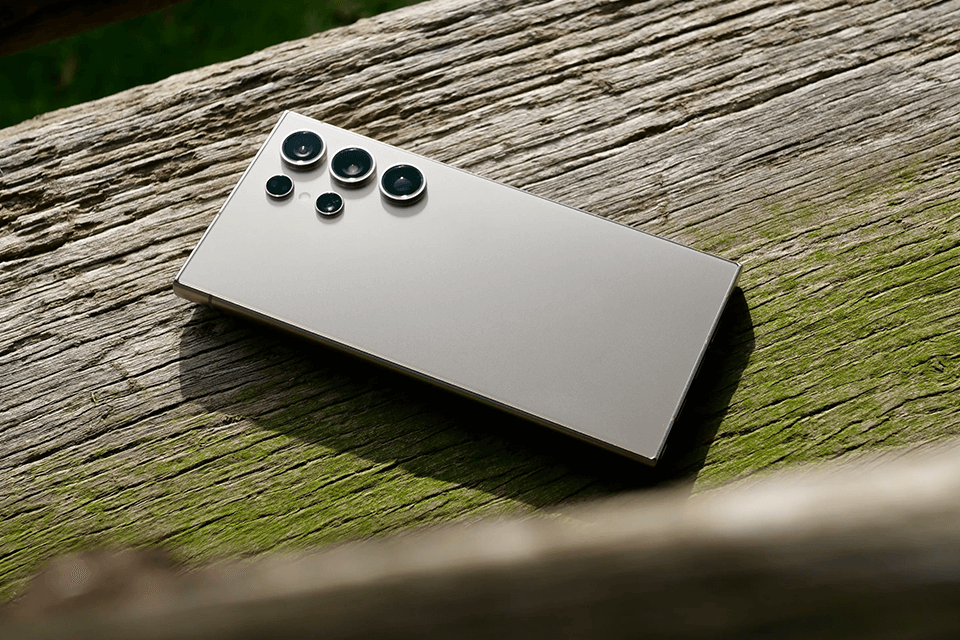
Rear: 200MP, 50MP Macro, 12MP UW, 10MP Telephoto | Front: 12MP | Storage: Up to 512GB | Display size: 6.8’’ | Processor: Qualcomm Snapdragon 8 Gen 3 | Battery: 5000mAh
The Galaxy S24 Ultra has arguably the best phone camera on the market due to the fantastic image quality it provides as well as its expansive functionality. Pictures taken using this phone for realtors look sharper and more detailed compared to the results you could get from previous Samsung smartphones or even the iPhone 15 Pro camera.
Made by Samsung Galaxy S24 Ultra
You can use it to receive top-quality images and videos that nearly match expensive professional cameras. Its zoom also works perfectly, enabling you to take detailed photos from a large distance while the night mode lets you enjoy impressive results even in extremely poor lighting conditions. The background blur added to the images also looks more natural compared to the previous models.
I appreciated the AI functionality included in this phone, as it simplifies the task of resizing and moving around objects in a picture while taking advantage of generative AI. Some of these tools were included in my Galaxy S10 already, but most of them were significantly improved in this iteration.
|
Samsung Galaxy S24 Ultra My Choice |
Samsung Galaxy S10 (my previous phone) |
|
|---|---|---|
|
Rear Camera |
200 MP + 50 MP Macro + 12 MP UW + 10MP |
16 MP + 12 MP + 12 MP UW |
|
Front Camera |
12MP |
10 MP |
|
Video |
Up to 8K at 30 fps |
Up to 4K at 60 fps |
|
Screen Size |
6.8” |
6.1” |
|
Battery Life |
5000mAh (about 24 hours) |
3400mAh (about 10 hours) |
|
AI Features |
|
|
|
Benefits |
|
|
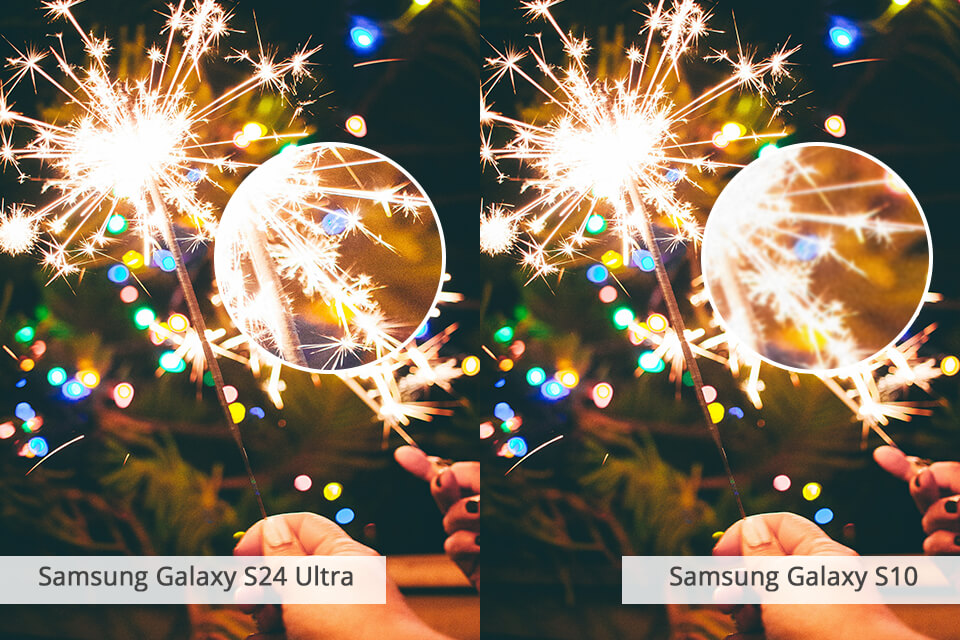
The pictures you take using S24 Ultra’s main camera look fantastic and the selfies produced by the front camera also ensure you’re looking your best. The zoom helps you preserve most of the details in the scene while the night mode excels at adapting to poor lighting at the cost of a bit of noise, which is a lot less noticeable compared to S10. The recorded videos also look crisp and smooth, which wasn’t the case with the Samsung Galaxy S10.
For photo and video
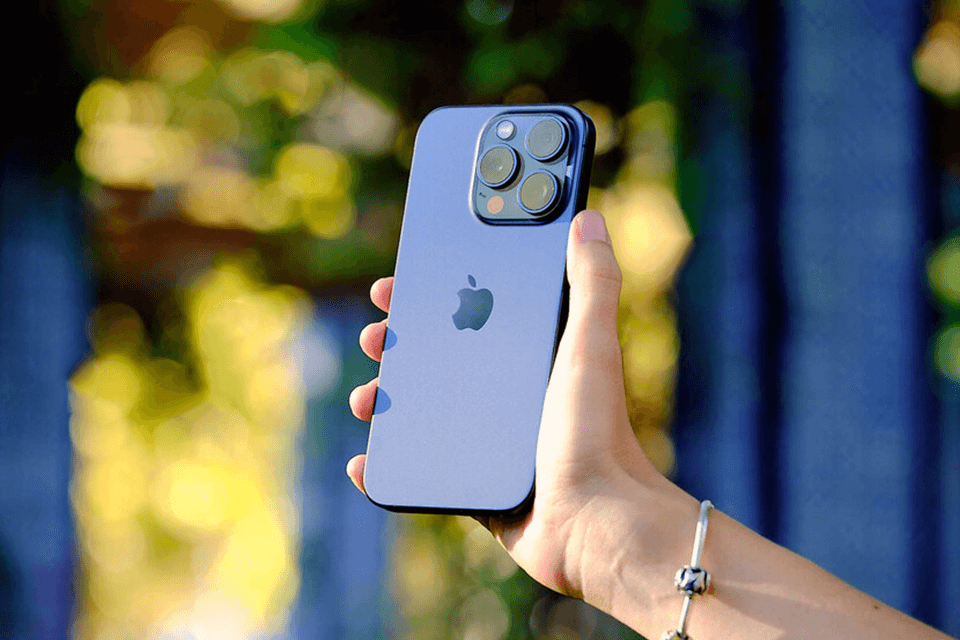
Rear: 48MP | Front: 12MP TrueDepth | Storage: Up to 1TB | Display size: 6.7’’ | Processor: A17 Pro chip | Battery: 4,422mAh
The enhanced zoom phone camera lens included in the iPhone 15 Pro Max has Apple fans excited the most, but it’s not the only innovation of this model. This premium smartphone deserves praise for its performance when taking both portrait and low-light pictures, often besting even the latest Galaxy camera.
Made by iPhone 15 Pro Max
Even though the iPhone 15 Pro Max isn’t the optimal model for macro photography, you can receive some fantastic wide-angle results with it. It captures a lot of detail and offers terrific sharpness and the contrast and exposure are also superior compared to the previous model.
Additionally, I appreciated the natural colors produced by this camera that make the pictures look more authentic. The video recording functionality of this phone also deserves the highest marks. As long as you invest in premium iPhone camera accessories, you can receive footage that rivals professional gear.
For Android users
Rear: 50 MP Wide, 48 MP UW, 48 MP Telephoto | Front: 10.5 MP front | Storage: Up to 512GB | Display size: 6.7” | Processor: Tensor G3 chip | Battery: 5050mAh
This smartphone is equipped with a state-of-the-art camera that allows me to snap crisp, colorful images of all genres. Whether I need to take a selfie, a group photo, or a low-light street picture, the result looks great. If you’re just a casual photographer, this phone camera can easily replace a midrange DSLR.
Made by Pixel 8 Pro
In terms of video recording, this model saw several improvements compared to the Pixel 7 Pro, but it still isn’t on the same level as Apple’s flagship iPhone. On the plus side, the stylish design, large screen, and future-proof software ensure you can rely on this phone for the next 7 years of your life without any issues.
Moreover, the implemented Tensor G3 allows you to enjoy new functionality similar to what you can find in Photoshop apps like Best Take, Magic Editor, and Audio Magic Eraser. The Video Boost tool exclusive to the Pixel 8 Pro is a great addition as well.
Budget model
Rear: 48MP Telephoto, 50MP Wide, 12MP UW | Front: 10.8MP | Storage: Up to 512GB | Display size: 6.7” | Processor: Tensor G2 chip | Battery: 5000mAh
The Pixel 7 Pro just might be the clearest camera phone on the market, as it sports a 50MP lens, which allows you to take breathtaking sunset photos that have natural yet vibrant colors. This model also has an improved 5x optical zoom that is perfect for snapping pictures of distant subjects while maintaining high clarity.
This main ultra-wide camera has an efficient AF system while the Macro mode enables you to get decent results when taking close-up photos of small subjects.
Made by Pixel 7 Pro
Pixel 7 Pro is equipped with Tensor G2, which powers the Night Sight feature, an enhanced Super Res Zoom, and the Face Unblur function. The provided low-light performance is also an improvement, as the built-in software does a good job brightening up the photo without requiring you to use a mini tripod.
When it comes to video recording, this smartphone offers 4K resolution support as well as a Cinematic Blur feature that lets you add artistic blur to your footage while Active Stabilization serves to improve the smoothness of the videos you record on the fly.
Advanced multitasking functionality

Rear: 50MP | Front: 10MP + 4MP Under Display | Storage: Up to 512GB | Display size: 7.6” | Processor: Snapdragon 8 Gen 2 | Battery: 4400mAh
Samsung Galaxy Z Fold 5 offers a fantastic 50MP camera that is suitable for taking beautiful pictures in a variety of shooting conditions. The trademarked folding design lets you employ the rear cameras for taking selfies, which allows you to receive a lot better results than if you’d to use the frontal camera.
Made by Samsung Galaxy Z Fold 5
The provided cameras are capable of handling most situations that don’t require zoom. The macro pictures you can take with this phone are a few levels below what you can get from S24 Ultra.
Galaxy Z Fold 5 lets you record videos in up to 8K resolution, which is great if you have an 8K-ready screen to view them on. Otherwise, you can still receive terrific footage by shooting in 4K or 1080p.
Small phone camera
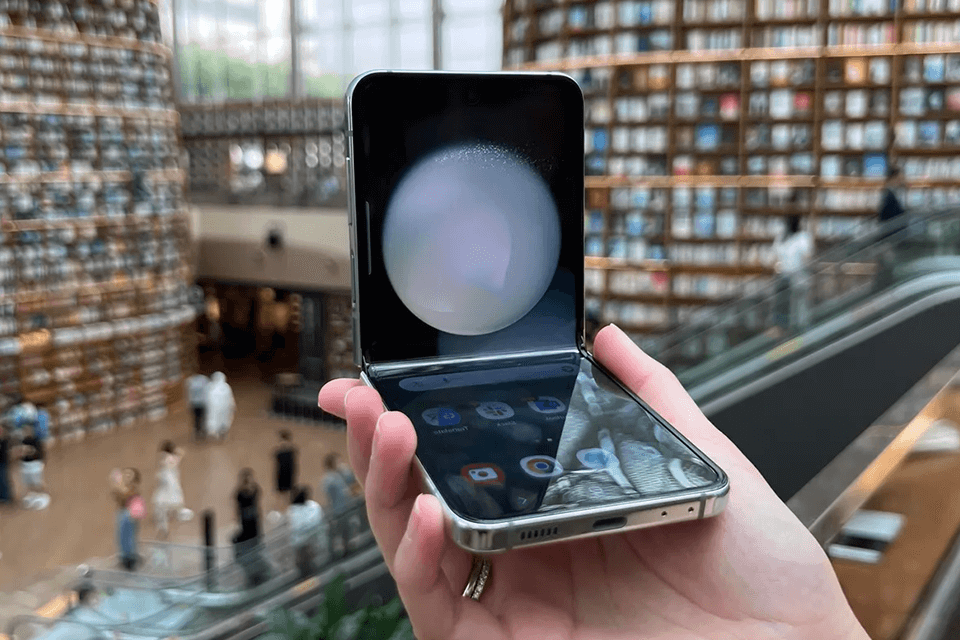
Rear: 12MP UW + 12MP Wide | Front: 10MP | Storage: Up to 512GB | Display size: 6.7” | Processor: Snapdragon 8 Gen 2 | Battery: 3700mAh
The pictures and videos I got from this phone look stunning, offering a lot of detail, crisp colors, and an impressive dynamic range. I also appreciated the level of quality provided by the wide-angle camera. While suffers a bit from oversaturated tones, that’s not something unusual for modern phone cameras.
Made by Galaxy Z Flip 5
The ultra-wide angle allowed me to snap some beautiful photos as well. This model doesn’t have a telephoto lens, meaning you’ll need to employ the digital zoom feature instead. While 2x still offers decent results in good lighting, anything beyond that will lead to a significant decrease in picture quality.
One of my favorite features of Galaxy Z Flip 5 is that it’s the sole flip foldable smartphone on the market that offers complete manual controls. Whenever you want to have more freedom over your shots, this phone lets you conveniently adjust the shutter speed and color temperature as you see fit.
Beautiful 4K screen
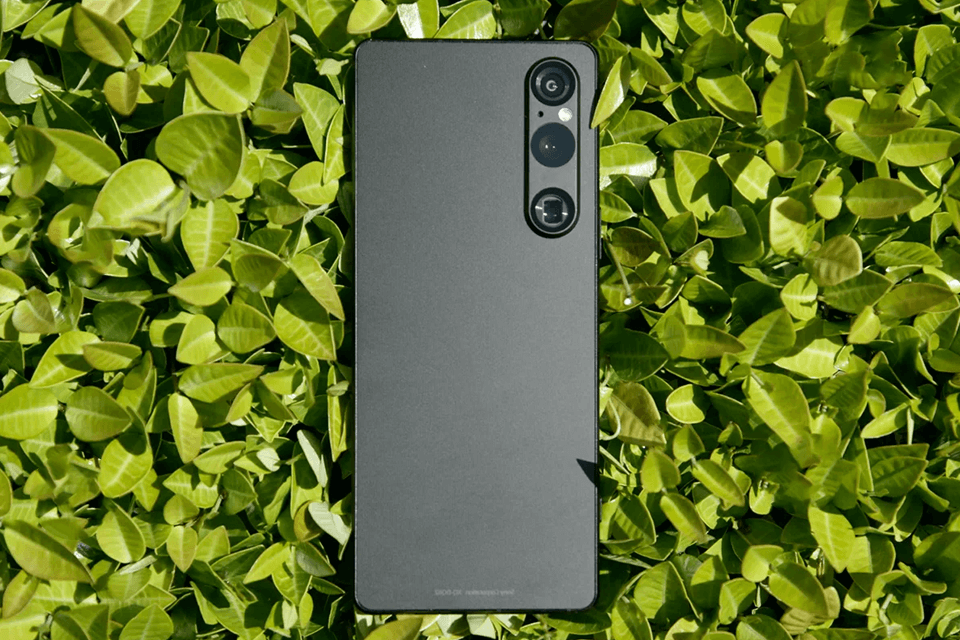
Rear: 48MP Main, 12MP Zoom, 12MP UW | Front: 12MP | Storage: 512GB | Display size: 6.5” | Processor: Qualcomm Snapdragon 8 Gen 2 | Battery: 5000mAh
The Xperia 1 V comes with 3 cameras that can help you receive incredible results as long as you’re knowledgeable enough to use its app. After you’ve mastered the process of changing the ISO sensitivity, white balance, focus type, metering, and other parameters on the go, you can take full advantage of the available manual mode.
Made by Sony Xperia 1 V
Pictures snapped using the primary camera look vibrant and sharp while preserving the scene’s natural colors.
I’m a huge fan of the physical shutter button, which can be semi-pressed to focus and completely pressed to take the photo. You can also use it to open the camera application. Xperia’s ultra-wide and telephoto lenses can’t provide the same level of detail as the primary camera, but they can still be useful when you need to encompass a wide landscape or take a picture of a distant object.
For beginners

Rear: 48MP Main | Front: 12MP TrueDepth | Storage: Up to 512GB | Display size: 6.1” | Processor: A16 Bionic | Battery: 3349mAh
In terms of pure photography, this model is the iPhone with the best camera, particularly if you’re a casual user who likes to simply aim and tap the camera to take a stunning photo for your social media feed without having to enhance it afterward.
On the other hand, more professional photographers will be disappointed in the lack of a RAW mode which is essential for having more image editing freedom during the post-processing stage.
Made by iPhone 15
Your photos will look incredible when viewed on this phone’s Super Retina XDR screen, but if you open them on a bigger monitor, you might notice some noise and artifacts that need to be dealt with.
Other than being arguably the phone with best the camera in its segment, the iPhone 15 also excels at recording beautiful handheld videos that don’t have to be stabilized using third-party software. However, if you want to elevate the quality of your footage even further, you should probably pick the Pro or Pro Max models to leverage the HDR Dolby Vision feature.
Cutting-edge "quad-curved" screen
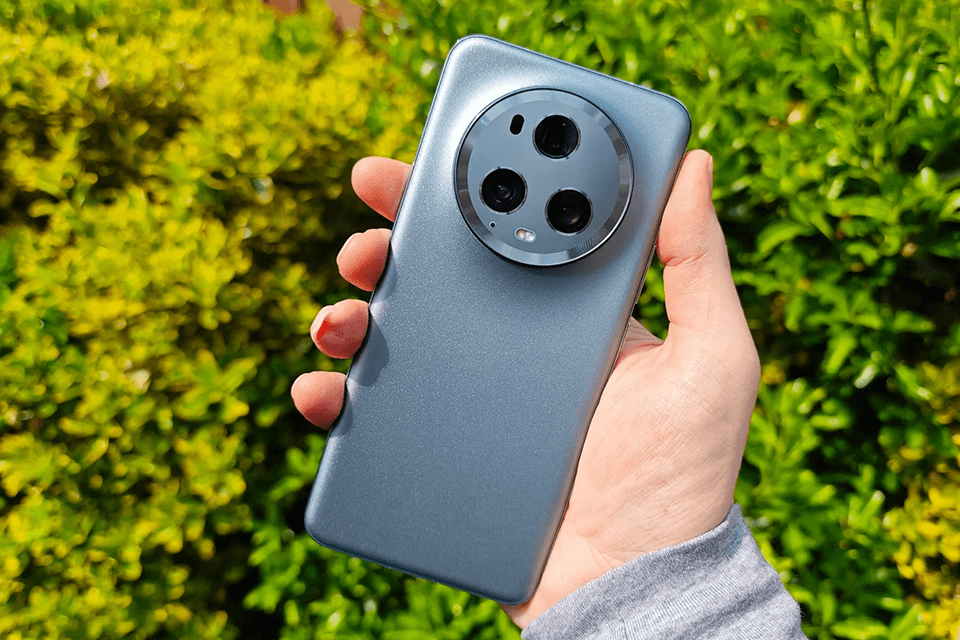
Rear: 50MP | Front: 10MP | Storage: 512GB | Display size: 6.81” | Processor: Snapdragon 8 Gen 2 chip | Battery: 5100mAh
When using this phone, I appreciated the fact that the photos I took had a lot of vibrant colors without looking oversaturated, blurry, or unnatural. Its main camera has a large sensor and aperture that make it a good fit for low-light photography since it can receive a lot more light than most alternative mobile devices. You don’t even need to set long exposures or perform in-depth editing afterward.
Honor Magic 5 also comes with a frontal 12MP selfie camera supplied with a 3D depth sensor. It’s another rare addition that I’ve grown to like. It’s useful for both secure face unlocking and taking beautiful portrait pictures.
Made by Honor Magic5 Pro
This smartphone offers impressive video recording capabilities, representing one of the best options in the Android ecosystem. The captured footage has accurate exposure, minimum noise, and minimum shake as long as you don’t pan or move the camera too abruptly.
For any photography genre
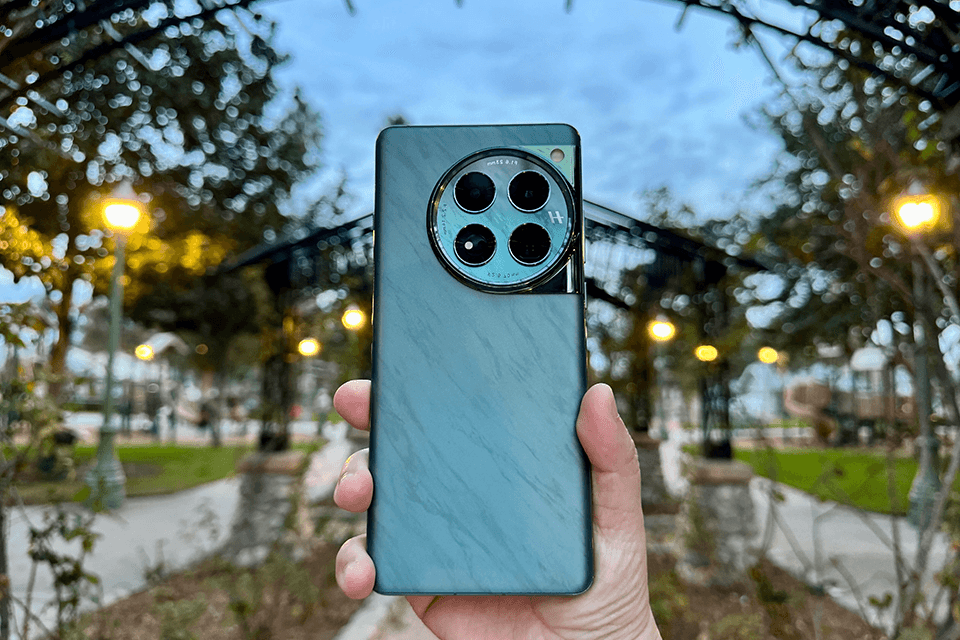
Rear: 50MP + 64MP + 48MP | Front: 32MP | Storage: Up to 512GB | Display size: 6.82” | Processor: AB Snapdragon 8 Gen 3 | Battery: 5400mAh
The most notable upgrade included in this model is the telephoto lens, which has an impressive 64MP sensor with a 3x optical zoom. As such, the zoomed-in photos are sharper and have more detail compared to even some of the most expensive smartphone cameras out there.
Made by OnePlus 12
OnePlus 12 excels at taking daytime pictures with an accurate white balance, which looks a lot more natural compared to Galaxy’s warmer palette. With the help of the 3x telephoto lens, I could take detailed animal photos without scaring them away. Just remember to turn off the Hasselblad watermark when you open the selfie app for the first time so that it doesn’t ruin your pictures.
On the other hand, if your goal is to take stunning telephoto photos or highly defined macro shots, you might be disappointed by this camera’s performance in such scenarios.
When deciding what phone has the best camera, the first thing you have to do is pick between the Android and iOS ecosystems. This choice will determine if you’ll be able to utilize Apple services like iMessage, iCloud, etc. If you can’t live without them, you should probably pick an iPhone.
If you’re not reliant on Apple services, you can consider purchasing an Android smartphone, as then you’ll be able to access a broader range of options, including the recently introduced folding models.
Types of pictures. If you’re frequently snapping pictures at sports events or you’re a fan of nature photography, then you can definitely benefit from a powerful zoom. Meanwhile, if you’re mostly taking portrait and group photos, then a phone with a more versatile camera is the better option.
Types and number of lenses. The availability of several cameras with different lenses and/or different sensors allows taking more interesting and higher-quality photos.
There are situations when it’s only possible to take a good photo with a wide-angle lens (when you need to encompass a larger scene and can’t take the shot from further out) or a telephoto lens (when you can’t approach the subject closer).
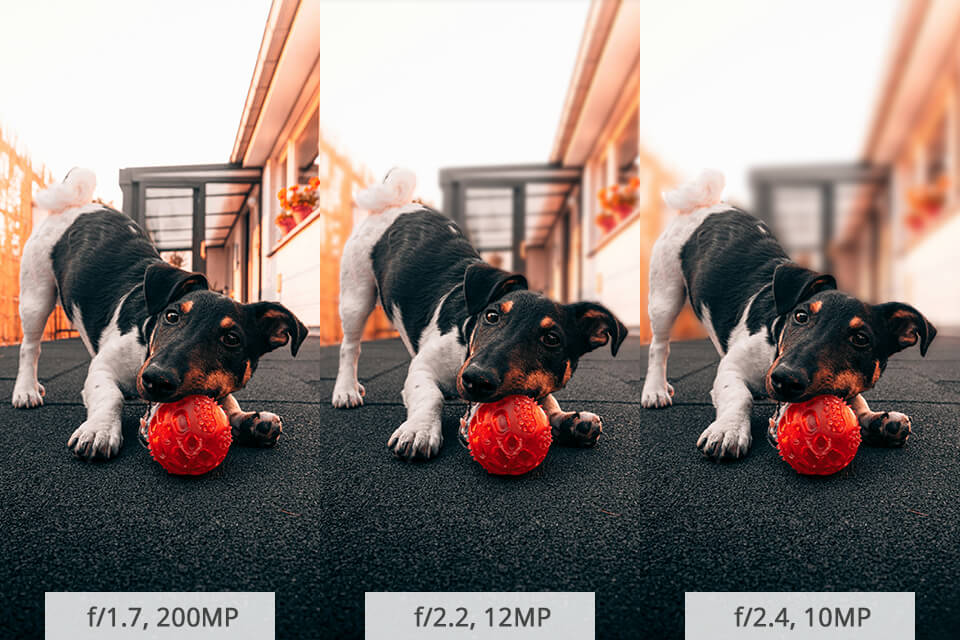
Aperture. Cameras with a bigger aperture (smaller ƒ-stop numbers mean a wider lens) capture more light, which is very important when shooting in low-light conditions.
Video. Learn the maximum supported resolution and framerate when picking a phone camera for video recording. The recommended resolution for enthusiasts is 1080p or 2K. If you decide to bump up the resolution even further, remember that the recorded file will take up a lot of storage space on your device.
Optical stabilization. I suggest buying a model with OIS (optical image stabilization), which is thankfully included in the majority of smartphones with the best cameras. Not only does this technology allow recording smoother videos, but it also increases image clarity in poor lighting.
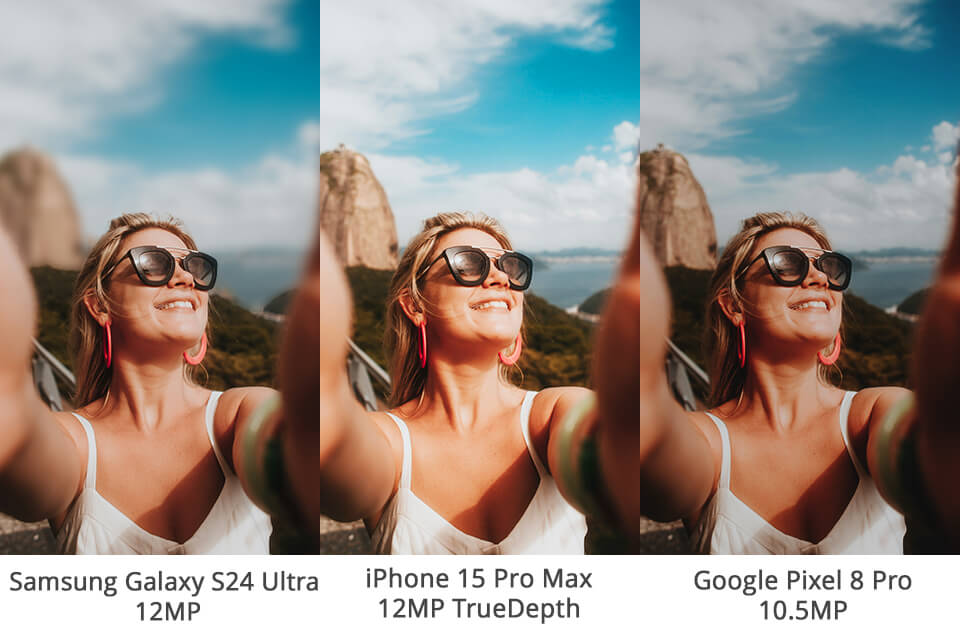
Front camera specifications. I suggest picking a model that has a camera with at least a 12MP frontal sensor. The best frontal lenses, like the ones included in iPhone 15 and Pixel 7, can match the results provided by the phone’s primary camera. Some models also come with two frontal cameras, with the secondary lens capturing the background detail, but such a design hasn’t been as common lately.
This year, the phone with the best camera is the Samsung Galaxy S24 Ultra.
Leading models like the iPhone 15 Pro or Samsung Galaxy S24 Ultra are capable of taking crisp, well-lit, detailed photos even at night. Even more budget-friendly models like the Pixel 8 come with a solid night mode that allows you to enjoy solid low-light performance.
Samsung phone cameras are better suited for low-light and macro photography while iPhones take higher-quality portraits. Both brands offer impressive video recording functionality, but Samsung phones are more flexible and offer support for 8K resolution, which might come in handy to some users.
Phones can take beautiful photos and so can DSLR cameras. Picking between the two is nearly impossible, as the quality of the produced images is determined by multiple factors. On average, you can still get better results from a dedicated digital camera compared to a regular smartphone, and premium DSLRs are still far superior to even the most expensive phone cameras.